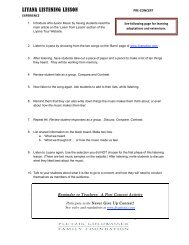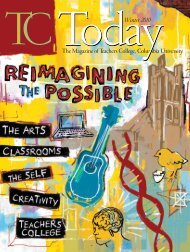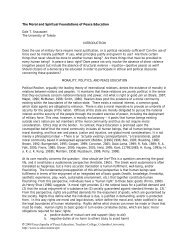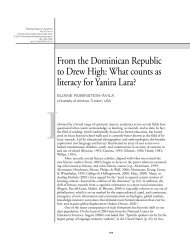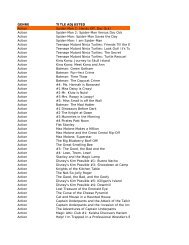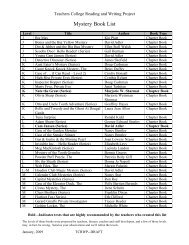TC Today - Teachers College Columbia University
TC Today - Teachers College Columbia University
TC Today - Teachers College Columbia University
Create successful ePaper yourself
Turn your PDF publications into a flip-book with our unique Google optimized e-Paper software.
Chandler, whose father was a photo engraver, studied<br />
these tools as a master’s degree student in <strong>TC</strong>’s Math,<br />
Science & Technology Department, and he teaches a<br />
course at the <strong>College</strong> on geospatial technologies. For light<br />
reading, he still absorbs books like The Visual Display of<br />
Quantitative Information, by the political scientist and statistician<br />
Edward Tufte. But he came to his present job via<br />
other interests, as well. While earning a second degree<br />
at the <strong>College</strong> in Social Studies and Education, he coauthored<br />
a chapter in <strong>TC</strong>’s nationally acclaimed “Teaching<br />
The Levees” curriculum, which explores civic issues raised<br />
by Hurricane Katrina and its aftermath. Titled “A Sense of<br />
Place, a Sense of Home: Using Geography to Understand<br />
the Levees Catastrophe,” the chapter takes as its starting<br />
point the comment made not long after Katrina by then-<br />
Speaker of the House Dennis Hastert that “it looks like a<br />
lot of that place could be bulldozed.” It poses the central<br />
question, “Given New Orleans’ geography and history of<br />
neglect of its infrastructure and natural resources, should<br />
the city be rebuilt? And if so, who gets to decide?” In one<br />
exercise, students are provided with an actual Army Corps<br />
of Engineers memo in which the Bush Administration<br />
is cited for insufficiently funding the completion of flood<br />
protection for New Orleans. In another, they grapple with<br />
whether American citizens can be accorded refugee status<br />
in their own country.<br />
Americans have the<br />
expectation that an ambulance<br />
will come within a three-day<br />
period, but it may not come for<br />
three weeks or at all.<br />
Such questions shape Chandler’s current work. Like his<br />
boss, NCDP founding Director Irwin Redlener, Chandler<br />
is particularly concerned with protecting the most vulnerable<br />
populations—children, the very poor and the elderly<br />
—who often face increased risk simply by virtue of where<br />
they live. New Orleans’ Ninth Ward, home to the city’s<br />
poorest citizens, is also in the most low-lying area, making<br />
it a prime target for flooding. In Haiti, the shanty<br />
towns—densely packed with loosely constructed, makeshift<br />
structures—were a death trap waiting to happen. And a<br />
cholera outbreak<br />
occurred after<br />
the earthquake<br />
primarily<br />
because most<br />
of the nation’s<br />
population<br />
lack access to<br />
any kind of<br />
health care services<br />
(and also,<br />
IT CAN HAPPEN HERe Above: The<br />
1918 influenza ward at Camp Funston,<br />
it seems, because Kansas. Bottom: Aerial view of New<br />
of a new strain Orleans after Hurricane Katrina.<br />
of the disease<br />
unwittingly brought in by foreign relief workers).<br />
Yet for all the deaths and damage wrought by violent<br />
disasters, Chandler believes that infectious disease—arising<br />
in the wake of these events or as epidemics triggered by<br />
other factors—may pose the greatest threat.<br />
“The world has seen an enormous population increase<br />
over a very short period—there will be nine billion people<br />
on the planet by 2050,” he says. “More and more people<br />
are migrating from the developing to the developed world,<br />
and vice versa, which is accelerating the spread of microbes.<br />
There’s increased urbanization into previously rural areas.<br />
And there are growing concerns about climate change and<br />
how that will impact the breeding patterns of various types<br />
of rodents and insects that carry disease.”<br />
Again, societal inequities increase the threat to the<br />
most vulnerable populations at risk—but they threaten<br />
everyone else, too.<br />
“When any segment of the population goes untreated,<br />
everyone is endangered,” Chandler says. “During the H1N1<br />
outbreak in the United States two years ago, many undocumented<br />
workers were afraid to go to health care facilities<br />
46 T C T O D A Y l s p r i n g 2 0 1 1<br />
Photo (t0p) courtesy of the National Museum of Health and Medicine;<br />
PHOTO (bottom) BY US Army Corps of Engineers



